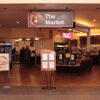Class attempts flash mob in local Target, discovers difficulties involved in coordinating efforts
Students from NIC instructor Josh Misner’s online communications/technology class donned red shirts and khaki pants (the official Target uniform) Feb. 11 at the local Target store in an effort to conduct an experiment on the effects of social media through flash mobs in our society.
What began nine years ago in New York City as an editor’s “random act with the sole purpose of confusing others” turned into a global fad overnight. The desire to not be left out was part of what made it grow.
Misner, whose class is studying Clay Shirky’s “Here Comes Everybody,” initially went on Facebook and invited 100 people to take part in the experiment, but only four students showed up to participate in the actual flash mob, and four to five others showed up just to witness the event.
“I knew it was going to fail; I knew it wasn’t even going to come close and, in a sense, I wanted it to fail,” Misner said. “Everybody liked the idea, but getting people to buy into it was a whole different story.”
Misner said they got the idea from the Improv Everywhere, a New York City prank group that entered a Best Buy dressed like the employees. A former Target employee himself, Misner said his “subtle” mob was just “innocent, harmless fun” who set out to go about their business. The idea was to pretend they were Target employees and observe the customers’ reactions.
Everett Cole, 21, communications, Post Falls, appeared nonchalant as he rearranged floor display models and asked customers if he could assist them. He said it was believable until they saw the Sonic logo on his shirt. Cole said he participates in activities like this all the time and really enjoys messing with people, which “violates their expectations of human behavior.”
Raife Nemitz and Molley Ourada paired up as associates taking inventory of shelf stock. They said they enjoyed themselves and figured they would have a fun experience. Cody Lang had the attitude “the more the merrier.”
“Target doesn’t appeal to me, so playing a spoof on them has no appeal,” Lisa Young said. She said the trick is to get an organization where there is more buy-in, such as the SUB.
The entire experience involved the exploration of how flash mobs aren’t as easy as they appear, Misner said, and that human interaction is very complex and detailed “with lots of subtleties that go into a recipe for success.” He then explained Shirky’s three-part recipe for success.
“You must have a promise, a tool and a bargain,” he said, and all ingredients must be present in order for it to succeed.
The promise is the “why” (why do I join, why do I buy into this), the tool is the “how” (how does it work, how do I do it) and the bargain “sets the rules of the road” (what do I expect and what is expected of me).
There must be enough of a why to want to show up, Misner said, and everyone can fill in the blanks with their own why. He said he made it implicit and simple as in ‘I really like flash mobs.’ The “hook” was providing extra credit to those who posted the best videos on Facebook or Youtube. A larger group must offer a more explicit and attractive promise, he said.
“Maybe a promise was needed to entail an incentive other than extra credit,” Alina Creighton said. The class agreed that had he made this a required assignment, more people would likely have shown up.
The tool comes down to the planning of the event itself, Misner said. “I could’ve made the ‘how’ stronger by giving more time to plan, but I simply said, ‘Show up on this date at this time.’”
More instructions make it clearer and easier to enact flash mobs, he said, comparing it to theater producer Joe Jacoby’s rendition of the choreographed “Thriller.”
Reino Hill said better planning would have put higher stakes in it, so one would feel obligated to attend.
There was nothing to overcome the obstacles, said Kelly Harpole. “The tools were there, but the timing was not right.”
Adding in expectations takes the uncertainty element out of “the rules of the road” and makes people more comfortable going into flash mobs, Misner said. He was “really vague” about the whole thing and left the bargain out completely, simply stating that “it could be fun,” he said.
Alyssa Pinkerton said, “It needs a purpose. The overall statement has to resonate with people getting involved.”
“A flash mob is so out of my comfort zone that it would take an act of God for me to participate,” Creighton said.
It all goes back to the primary source of motivation, Misner said. Flashmobs require work and planning. It’s not as easy as just throwing it together and putting it up on YouTube, he said.
He said the failed exercise did not deter him at all from planning future experiments, and the conclusion that can be gathered from all of this is that the relationship among all the factors to make a flash mob successful is a delicate one.













